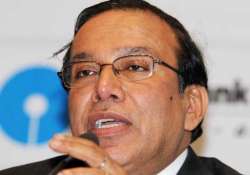SBI pitches for cut in repo rate, CRR
Bhubaneswar, Jan 22: Pitching for a cut in interest rates and cash reserve ratio by the Reserve Bank of India, State Bank of India Chairman Pratip Chaudhuri has said the move will boost investment and

Bhubaneswar, Jan 22: Pitching for a cut in interest rates and cash reserve ratio by the Reserve Bank of India, State Bank of India Chairman Pratip Chaudhuri has said the move will boost investment and growth.
“As RBI's monetary policy review is slated on January 29, we have already requested for a cut in cash reserve ratio by up to 100 basis points (1 per cent) and repo rate by 50 basis points (0.5 per cent),” Chaudhuri told reporters here at an event.
Stating that he was thankful to RBI for reducing CRR, the amount banks have to keep as deposits with the central bank, from six per cent to 4.25 per cent, he said in view of high inflation prevailing in the country the interest rate needs to be lowered to avoid stagnation.
“Inflation can be contained by boosting the manufacturing sector and raising supply for which high investment is required,” he said, adding that interest rates should be cut to increase investment.
“If inflation and stagnation are allowed to persist, it will create a grim situation of stagflation,” he said.
Lowering of interest rates, he said would considerably improve the investment climate which remained sluggish.
Higher investments
Rise in investment would also brighten the employment scenario by giving a boost to economic activities, the SBI chief said, warning that India might face a Europe-like situation if the prevailing scenario continues.
Non-performing assets
Admitting the growing non-performing assets of SBI, Chaudhuri said it was primarily due to economic slowdown and the bank has decided to be patient as “this is a cyclic process and well under control”.
Voicing concern over situation in states like Odisha, particularly in the steel sector, Chaudhuri said restrictions clamped recently due to environmental reasons and excess mining had caused a setback and NPAs in Odisha stood at about Rs 2,500 crore.
“But in these cases if we don't remain patient, the situation will worsen,” he said, adding that “we need to differentiate between wilful defaulters and others''.
Stating that investments in steel, power, aluminium and fertiliser sectors had slowed down, Chaudhuri said whatever fund was sanctioned earlier is now being utilised for operations.
The total exposure of SBI in the steel sector is around Rs 18,000 crore and in Odisha it is Rs 4,000 crore, he said, adding that the main challenge at present is in the field of lending.
Capital infusion
Referring to capital infusion, the SBI chief said the Central Government is extending about Rs 3,000 crore by the end of the current fiscal.
This was part of Rs 12,000-crore infusion plan approved by the Finance Ministry recently.
Last fiscal, the Government had infused Rs 7,900 crore in SBI to increase the Tier-I capital. Following the capital infusion in March last year, the Government holding in SBI rose to 61.58 per cent from 59.4 per cent.
“As RBI's monetary policy review is slated on January 29, we have already requested for a cut in cash reserve ratio by up to 100 basis points (1 per cent) and repo rate by 50 basis points (0.5 per cent),” Chaudhuri told reporters here at an event.
Stating that he was thankful to RBI for reducing CRR, the amount banks have to keep as deposits with the central bank, from six per cent to 4.25 per cent, he said in view of high inflation prevailing in the country the interest rate needs to be lowered to avoid stagnation.
“Inflation can be contained by boosting the manufacturing sector and raising supply for which high investment is required,” he said, adding that interest rates should be cut to increase investment.
“If inflation and stagnation are allowed to persist, it will create a grim situation of stagflation,” he said.
Lowering of interest rates, he said would considerably improve the investment climate which remained sluggish.
Higher investments
Rise in investment would also brighten the employment scenario by giving a boost to economic activities, the SBI chief said, warning that India might face a Europe-like situation if the prevailing scenario continues.
Non-performing assets
Admitting the growing non-performing assets of SBI, Chaudhuri said it was primarily due to economic slowdown and the bank has decided to be patient as “this is a cyclic process and well under control”.
Voicing concern over situation in states like Odisha, particularly in the steel sector, Chaudhuri said restrictions clamped recently due to environmental reasons and excess mining had caused a setback and NPAs in Odisha stood at about Rs 2,500 crore.
“But in these cases if we don't remain patient, the situation will worsen,” he said, adding that “we need to differentiate between wilful defaulters and others''.
Stating that investments in steel, power, aluminium and fertiliser sectors had slowed down, Chaudhuri said whatever fund was sanctioned earlier is now being utilised for operations.
The total exposure of SBI in the steel sector is around Rs 18,000 crore and in Odisha it is Rs 4,000 crore, he said, adding that the main challenge at present is in the field of lending.
Capital infusion
Referring to capital infusion, the SBI chief said the Central Government is extending about Rs 3,000 crore by the end of the current fiscal.
This was part of Rs 12,000-crore infusion plan approved by the Finance Ministry recently.
Last fiscal, the Government had infused Rs 7,900 crore in SBI to increase the Tier-I capital. Following the capital infusion in March last year, the Government holding in SBI rose to 61.58 per cent from 59.4 per cent.